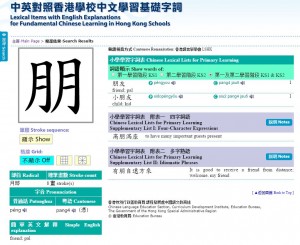中英對照香港學校中文學習基礎字詞 Online tools of Simple Characters and Vocabularies
http://www.edbchinese.hk/lexlist_en/
Research Results
With reference to the principles above, it was decided to reach a collection of 9,706 words in the final lexical list, where the majority of words are common in the three regions across the Strait and a small portion are words solely found in Hong Kong. There are 4,914 words and 4,792 words in Key Stage I (Primary 1 to 3) and Key Stage II (Primary 4 to 6) respectively. The distribution of the two Key Stages of learning is close to the two word lists made by Hong Kong and Beijing. There are 3,171 characters in the lexical lists, excluding those in the supplementary lists. The results reflect the objective situation of language use in Hong Kong. As the coverage of various types of reference word lists is wide and the selection process has followed certain criteria, and the source of every entry of the list could be traced, the total number of lexical items is thus slightly higher than that of the List of Lexical Items for Teaching Reference in Primary Schools (1996), which should be appropriate in terms of quantity.
5,860 words of the word list are from the List of Lexical Items for Teaching Reference in Primary Schools (1996), amounting to 86.62% of the list. 2,461 Chinese characters are from List of Lexical Items for Teaching Reference in Primary Schools (1996) amounting to 97.97% of Chinese characters on the list; while 2,566 characters are from the List of Commonly Used Characters at Primary Level (1990), amounting to 98.69% of Chinese characters in the list. Researchers believe that the proportion of old and new lexical items basically fulfils the expectation of language educators in primary schools. It not only shows that the old and new word lists are along the same lines, but also reflects fully the language development and changes in Hong Kong in recent decades.
[ ▲ Back to top ]
The completion of the “Research on Hong Kong Chinese Lexicons for Primary Learning” has relied heavily on the concerted efforts of experts, scholars, experienced teachers and professionals from relevant organisations. During the research, I was deeply touched by the efforts of Prof CHOW Kwok-ching of Hong Kong Baptist University and Mr LEE Siu-tat, Mr CHENG Man-leung, Ms LAI Sau-mei, Ms SUN San-tak, Ms AUYEUNG Oi-ling, Ms Alice SZE Chi-wing, Ms Alice CHAN Suk-ping of the Education Bureau of HKSAR, all of whom participated in reviewing the materials, and by Ms TANG Mei-lan, Ms MOU Suet-fong, Ms TAM Kit-wai, all experienced language teachers who participated in the teachers’ focus group.
We hereby express our sincere gratitude to the experts and consultants from Mainland China for their guidance and assistance, including Prof Fu Yonghe, Prof Chen Zhangtai, Prof Li Xingjian, Prof Tong Lequan and Prof Liu Yinglin. We also express a special thank you to the State Language Commission (國家語言文字工作委員會) and Taiwan’s Ministry of Education for their generous approval of the use of their lexical statistics.
CHAN Shui-duen
Department of Chinese & Bilingual Studies
The Hong Kong Polytechnic University
May 2007
http://www.edbchinese.hk/lexlist_en/fw_yanjiu_jianjie.htm
研究原則
綜合上述研究過程,研究人員在確定詞語表收詞範圍時,主要考慮三方面因素:
一、語文材料中詞語使用和分布等狀況;
二、香港地區詞語使用的特點;
三、小學教育與兒童生活的實際情況。
研究主要遵循以下原則:
- 科學性 ─ 首先體現在詞語的切分標準方面:研究人員依據現代漢語研究成果,採納了大多數專家學者和權威工具書的切分標準,用以界定詞與非詞。其次體現在篩選詞語的思路以及研究手段方面:研究人員審核詞語的常用程度,通過電腦獲得、處理大量數據,對頻率高、分布範圍廣的詞語優先選擇。
- 客觀性 ─ 主要體現在尊重語言的現實狀況方面:研究人員以客觀統計資料作為基礎,盡量減少主觀意見或憑個人經驗篩選詞語。這要求研究人員洞悉語言的發展趨勢;例如有些普通話詞語近年開始在香港流行,如「公斤、賓館、沙發」;有些典型香港地區詞語也逐漸在內地廣泛使用,甚至進入現代漢語語匯,如「酒樓、的士、洗手間、按揭」;對這兩種詞語,研究人員本著尊重客觀現實的精神,選收進新詞語表。
- 針對性 ─ 首先體現在香港地區使用中文的現實狀況和特殊性方面。多年來,一些香港地區詞語在內地或者另有說法,或者並不流行,但是不會造成溝通障礙;例如「蠔油、公仔、餐包、蛋撻」。其次體現在與兒童生活、學校生活關係密切的詞語方面;這些詞語在社會生活中不算十分常用,但是在兒童生活和學校活動中相當重要,如「蝴碟、狐狸、班級、課室」。這種詞語也選進了新詞語表。
- 系統性 ─ 首先體現在統一處理具有共同特徵的詞語方面。研究人員按系列進行配套選擇,如表示方向的「東、南、西、北」,表示貨幣單位的「人民幣、港元、美元」。其次是對同類詞語進行統一處理,如親屬稱謂一般收雙音節詞,如「爸爸、媽媽、哥哥、妹妹、叔叔、舅舅」。
[ ▲返回頁首 ]
按照以上原則,詞語表最終確定收錄 9,706 詞語,其中絕大多數是兩岸三地共有的詞語,少數是香港地區獨有的詞語。
第一學習階段(小一至小三)收錄 4,914 詞語,
第二學習階段(小四至小六)收錄 4,792 詞語。
兩個學習階段的分布情況,與香港、北京兩份小學詞語表接近。不計附表在內,詞語表包含 3,171 字。這個結果反映了香港地區語文運用的客觀情況。由於參考的各種詞語表涵蓋面廣,而且根據一定原則進行篩選,入選的詞語來之有據,總數稍高於 1996 年的香港小學教學參考詞語表,數量應該是比較合適的。
詞語表中的詞語,有 5,860 詞語沿襲了 1996 年香港小學教學參考詞語表,佔該表詞語86.62%。詞語表中的漢字,有 2,461 字沿襲了 1996 年香港小學教學參考詞語表,佔該表漢字 97.97%;有 2,566 字沿襲了 1990 年香港小學常用字表,佔該表漢字 98.69%。研究人員相信,新舊字詞比例大體符合小學語文教育工作者的期望,既體現了新舊字詞表一脈相承,也充分反映了香港近數十年語言生活的發展和變化。
[ ▲返回頁首 ]
「香港小學學習字詞研究」能夠完成,實在依靠專家學者、經驗教師和有關機構人員的共同努力。在研究過程中,尤以香港浸會大學周國正教授和香港教育局李小達先生、鄭文亮先生、黎秀薇女士、孫省德女士、歐陽藹凌女士、施志咏女士、陳淑萍女士參加審閱,資深語文教師唐美蘭女士、繆雪芳女士、譚潔慧女士參加教師焦點小組,使我深受感動。
我們還獲得內地專家顧問傅永和教授、陳章太教授、李行健教授、佟樂泉教授、劉英林教授的指導和幫助,在此謹致誠摯謝意;而國家語言文字工作委員會和臺灣的教育部門慨允本研究使用其詞語統計資料,謹在此一併致謝。
香港理工大學中文及雙語學系 陳瑞端
